A Novel Vibration Piezoelectric Generator Based on Flexible Piezoelectric Film Composed of PZT and PI Layer
Abstract
:1. Introduction
2. Operating Principle
3. Electromechanical Model
4. Structural Simulation Analysis
5. Experimental Analysis
- (1)
- Under instantaneous vibration excitation, the generator generated transient voltage response, and the response time lasted 0.2 s–0.3 s. Under different load resistances, the voltage response curves of the piezoelectric generator were similar, and the response amplitudes were different. When the load resistance increased, the maximum voltage response amplitude also increased.
- (2)
- As the load resistance R increased, the maximum output voltage increased. For the output power, the maximum instantaneous power occurred at R = 35 KΩ and was 2.44 mW.
- (1)
- Under the excitation of a continuous vibration signal, the displacement of the piezoelectric MFC changed regularly and continuously in the range of 0–2 mm. The average displacement was 1.23 mm.
- (2)
- At different exciting frequencies and load resistances, the voltage response of the piezoelectric generator was similar. The difference was that the maximum output voltage increased with the increase in excitation frequency and load resistance.
- (3)
- When the excitation frequency and load resistance were constant, the output voltage of the generator varied regularly with time. The output voltage waveform approximated sinusoidal law.
- (1)
- With the increase in load resistance, the peak voltage and effective value first increased, and then tended to be stable or even slightly decrease. The maximum peak voltage and effective voltage were 12.22 V and 8.64 V, respectively, and occurred at the load resistance of 40 kΩ and the excitation frequency of 25 Hz. When the load resistance was constant, the peak voltage and effective voltage increased with the increase in excitation frequency. When the load resistance was 40 kΩ, the voltage change was more obvious.
- (2)
- When the excitation frequency was less than 20 Hz, the maximum power and average power tended to be stable with the change in load resistance. When the excitation frequency was greater than 20 Hz, the output power was not stable. The power decreased with the increase in load resistance. The maximum power and average power of the piezoelectric generator were 4.82 mW and 2.41 mW, respectively, occurring at the load resistance of 20 kΩ and the excitation frequency of 25 Hz.
- (3)
- The instantaneous voltage of the generator was very close to the simulated voltage. The maximum error between the instantaneous voltage corresponding to different load resistor and the simulation voltage was 15.7%, which occurred when R was 10 kΩ. The instantaneous voltage and simulation voltage had the same variation rule, and the instantaneous voltage was less than the continuous voltage.
- (4)
- As the load resistance changed, the maximum simulation power values remained unchanged. The reason was that the output power was not affected by the load resistance based on Equation (12). The instantaneous power fluctuated within the range of 2.34 mW–2.44 mW. The continuous power increased first and then decreased, and its power range was 3.25 mW–4.82 mW. When the load resistance R was 20 kΩ and 25 kΩ, the continuous power was close to the average power, and the errors were 5.24% and 2.84%, respectively. There was a significant difference between instantaneous power and continuous power. For instantaneous power, which was generated only for a very short time, due to the lack of continuous excitation, its power was relatively small. For continuous power, the maximum output power was close to the calculated value. When the load resistance was small, the energy was not fully released and the power was small, while when the load resistance was large, the stability of the output power was reduced and the power was slightly reduced. Hence, the instantaneous power and continuous power in Figure 12f were inconsistent with the calculated results.
6. Conclusions
- (1)
- The transient excitation voltage of the proposed piezoelectric generator increased with the increase in load resistance, while the continuous excitation voltage increased first and then tended to be stable or slightly decreased.
- (2)
- The maximum continuous power produced by the piezoelectric generator was about 4.82 mW.
- (3)
- The simulation results agreed well with the experimental results on continuous excitation voltage and power with load resistances of 20 kΩ and 25 kΩ.
Author Contributions
Funding
Institutional Review Board Statement
Informed Consent Statement
Data Availability Statement
Conflicts of Interest
References
- Shakeel, M.; Rehman, K.; Ahmad, S.; Amin, M.; Iqbal, N.; Khan, A. A low-cost printed organic thermoelectric generator for low-temperature energy harvesting. Renew. Energy 2021, 167, 853–860. [Google Scholar] [CrossRef]
- Mishra, S.; Unnikrishnan, L.; Nayak, S.K.; Mohanty, S. Advances in piezoelectric polymer composites for energy harvesting applications: A systematic review. Macromol. Mater. Eng. 2019, 304, 1800463. [Google Scholar] [CrossRef] [Green Version]
- Teng, H.C.; Kok, B.C.; Uttraphan, C.; Yee, M.H. A review on energy harvesting potential from living plants: Future energy resource. Int. J. Renew. Energy Res. 2018, 8, 2598–2614. [Google Scholar]
- Viet, N.; Xie, X.; Liew, K.; Banthia, N.; Wang, Q. Energy harvesting from ocean waves by a floating energy harvester. Energy 2016, 112, 1219–1226. [Google Scholar] [CrossRef]
- Sari, I.; Balkan, T.; Kulah, H. An electromagnetic micro power generator for wideband environmental vibrations. Sens. Actuators A Phys. 2008, 145, 405–413. [Google Scholar] [CrossRef]
- El-Rayes, K.; Gabran, S.; Abdel-Rahman, E.; Melek, W. Variable-Flux Biaxial Vibration Energy Harvester. IEEE Sens. J. 2018, 18, 3218–3227. [Google Scholar] [CrossRef]
- Hadas, Z.; Vetiska, V.; Vetiska, J.; Krejsa, J. Analysis and efficiency measurement of electromagnetic vibration energy harvesting system. Microsyst. Technol.-Micro-Nanosyst.-Inf. Storage Process. Syst. 2016, 22, 1767–1779. [Google Scholar] [CrossRef]
- Wang, X.; John, S.; Watkins, S.; Yu, X.; Xiao, H.; Liang, X.; Wei, H. Similarity and duality of electromagnetic and piezoelectric vibration energy harvesters. Mech. Syst. Signal Process. 2014, 52–53, 672–684. [Google Scholar]
- Liu, C.C.; Jing, X.J. Vibration energy harvesting with a nonlinear structure. Nonlinear Dyn. 2016, 84, 2079–2098. [Google Scholar] [CrossRef]
- Triplett, A.; Quinn, D.D. The effect of non-linear piezoelectric coupling on vibration-based energy harvesting. J. Intell. Mater. Syst. Struct. 2009, 20, 1959–1967. [Google Scholar] [CrossRef]
- Iqbal, M.; Nauman, M.M.; Khan, F.U.; Abas, P.E.; Cheok, Q.; Iqbal, A.; Aissa, B. Vibration-based piezoelectric, electromagnetic, and hybrid energy harvesters for microsystems applications: A contributed review. Int. J. Energy Res. 2021, 45, 65–102. [Google Scholar]
- Zhang, Y.; Wang, T.; Luo, A.; Hu, Y.; Li, X.; Wang, F. Micro electrostatic energy harvester with both broad bandwidth and high normalized power density. Appl. Energy 2018, 212, 362–371. [Google Scholar] [CrossRef]
- Shao, J.; Zhou, L.; Chen, Y.; Liu, X.; Ji, M. Model-based dielectric constant estimation of polymeric nanocomposite. Polymers 2022, 14, 1121. [Google Scholar] [CrossRef]
- Moradian, S.; Akhkandi, P.; Huang, J.; Gong, X.; Abdolvand, R. A Battery-Less Wireless Respiratory Sensor Using Micro-Machined Thin-Film Piezoelectric Resonators. Micromachines 2021, 12, 363. [Google Scholar] [CrossRef] [PubMed]
- Titsch, C.; Li, Q.; Kimme, S.; Drossel, W.G. Proof of Principle of a Rotating Actuator Based on Magnetostrictive Material with Simultaneous Vibration Amplitude. Actuators 2020, 9, 81. [Google Scholar] [CrossRef]
- Zhang, B.; Li, H.; Zhou, S.; Liang, J.; Gao, J.; Yurchenko, D. Modeling and analysis of a three-degree-of-freedom piezoelectric vibration energy harvester for broadening bandwidth. Mech. Syst. Signal Process. 2022, 176, 109169. [Google Scholar] [CrossRef]
- Liu, M.; Qian, F.; Mi, J.; Zuo, L. Dynamic interaction of energy-harvesting backpack and the human body to improve walking comfort. Mech. Syst. Signal Process. 2022, 174, 109101. [Google Scholar] [CrossRef]
- Wang, L.; Wu, Z.T.; Liu, S.; Wang, Q.; Sun, J.; Zhang, Y.; Qin, G.; Lu, D.; Yang, P.; Zhao, L.; et al. Uniform Stress Distribution of Bimorph by Arc Mechanical Stopper for Maximum Piezoelectric Vibration Energy Harvesting. Energies 2022, 15, 3268. [Google Scholar] [CrossRef]
- Morel, A.; Brenes, A.; Gibus, D.; Lefeuvre, E.; Gasnier, P.; Pillonnet, G.; Badel, A. A comparative study of electrical interfaces for tunable piezoelectric vibration energy harvesting. Smart Mater. Struct. 2022, 98, 107209. [Google Scholar]
- Rojas, E.F.; Faroughi, S.; Abdelkefi, A.; Park, Y.H. Investigations on the performance of piezoelectric-flexoelectric energy harvesters. Appl. Energy 2021, 288, 116611. [Google Scholar] [CrossRef]
- Sharma, M.; Chauhan, A.; Vaish, R. Energy harvesting using piezoelectric cementitious composites for water cleaning applications. Mater. Res. Bull. 2021, 137, 111205. [Google Scholar] [CrossRef]
- Pan, J.; Qin, W.; Yang, Y.; Yang, Y. A collision impact based energy harvester using piezoelectric polyline beams with electret coupling. J. Phys. D Appl. Phys. 2021, 54, 225502. [Google Scholar] [CrossRef]
- Liu, M.; Xia, H.; Liu, G.Q. Experimental and numerical study of underwater piezoelectric generator based on Vortex-induced Vibration. Eng. Res. Express 2021, 3, 045056. [Google Scholar]
- Zhou, L.; Liu, Y.; Ma, L.; Wu, Y. Piezoelectric generator with nonlinear structure. Proc. Inst. Mech. Eng. Part L J. Mater. Des. Appl. 2021. [Google Scholar] [CrossRef]
- Zou, H.; Shi, Q.; Cai, H.; Liu, J. The multi-harmonic excitation characteristic of airflow piezoelectric generator. J. Vibroeng. 2021, 23, 1219–1229. [Google Scholar] [CrossRef]
- Ha, Y.; Jeong, S.; Cheo, S.; Lee, B.; Kim, M.; Park, T. Generating characteristics of an eye-shaped piezoelectric generator. Ceram. Int. 2015, 41, S691–S694. [Google Scholar] [CrossRef]
- Ramadan, K.S.; Sameoto, D.; Evoy, S. A review of piezoelectric polymers as functional materials for electromechanical transducers. Smart Mater. Struct. 2014, 23, 033001. [Google Scholar] [CrossRef]
- Baur, C.; Apo, D.J.; Maurya, D.; Priya, S.; Voit, W. Advances in piezoelectric polymer composites for vibrational energy harvesting. In Polymer Composites for Energy Harvesting, Conversion, and Storage; American Chemical Society: Washington, DC, USA, 2014; pp. 1–27. [Google Scholar]
- Covaci, C.; Gontean, A. Piezoelectric energy harvesting solutions: A review. Sensors 2020, 20, 3512. [Google Scholar] [CrossRef]
- Shao, J.; Liao, X.; Ji, M.; Liu, X. A Modeling Study of the Dielectric Property of Polymeric Nanocomposites Based on the Developed Rayleigh Model. ACS Appl. Polym. Mater. 2021, 3, 6338–6344. [Google Scholar] [CrossRef]
- Lin, J.; Malakooti, M.H.; Sodano, H.A. Thermally stable poly (vinylidene fluoride) for high-performance printable piezoelectric devices. ACS Appl. Mater. Interfaces 2020, 12, 21871–21882. [Google Scholar] [CrossRef]
- Gong, S.; Zhang, B.; Zhang, J.; Wang, Z.L.; Ren, K. Biocompatible poly (lactic acid)-based hybrid piezoelectric and electret nanogenerator for electronic skin applications. Adv. Funct. Mater. 2020, 30, 1908724. [Google Scholar] [CrossRef]
- Yazdani, A.; Manesh, H.D.; Zebarjad, S.M. Piezoelectric properties and damping behavior of highly loaded PZT/polyurethane particulate composites. Ceram. Int. 2021, 7, 126. [Google Scholar] [CrossRef]
- Sappati, K.K.; Bhadra, S. Piezoelectric polymer and paper substrates: A review. Sensors 2018, 18, 3605. [Google Scholar] [CrossRef] [PubMed] [Green Version]
- Dagdeviren, C.; Yang, B.D.; Su, Y.; Tran, P.L.; Joe, P.; Anderson, E.; Xia, J.; Doraiswamy, V.; Dehdashti, B.; Feng, X.; et al. Conformal piezoelectric energy harvesting and storage from motions of the heart, lung, and diaphragm. Proc. Natl. Acad. Sci. USA 2014, 111, 1927–1932. [Google Scholar] [CrossRef] [PubMed] [Green Version]
- Deng, J.; Guasch, O.; Zheng, L.; Song, T.; Cao, Y. Semi-analytical model of an acoustic black hole piezoelectric bimorph cantilever for energy harvesting. J. Sound Vib. 2021, 494, 115790. [Google Scholar] [CrossRef]
- Derakhshani, M.; Momenzadeh, N.; Berfield, T.A. Analytical and experimental study of a clamped-clamped, bistable buckled beam low-frequency PVDF vibration energy harvester. J. Sound Vib. 2021, 497, 115937. [Google Scholar] [CrossRef]
- Kim, J.H.; Kim, B.; Kim, S.W.; Kang, H.W.; Park, M.-C.; Park, D.H.; Ju, B.K.; Choi, W.K. High-performance coaxial piezoelectric energy generator (C-PEG) yarn of Cu/PVDF-TrFE/PDMS/Nylon/Ag. Nanotechnology 2021, 32, 145401. [Google Scholar] [CrossRef]
- Ma, Y.; Wang, J.; Li, C.; Fu, X. A Micro-Power Generator Based on Two Piezoelectric MFC Films. Crystals 2021, 11, 861. [Google Scholar] [CrossRef]
- Bai, F.X.; Zhang, M.J.; Sun, J.Z.; Sun, J.Z.; Dong, W.J. Research and design of wearable cylindrical shell piezoelectric energy harvester. Pie-Zoeletrics Acoustoopics 2021, 43, 39–44. [Google Scholar]
- Wilkie, W.K.; Bryant, R.G.; Fox, R.L.; Hellbaum, R.F.; High, G.W.; Jalink, A., Jr.; Little, B.D.; Mirick, P.M. Method of Fabricating a Piezoelectric Composite Apparatus. US Patent No. 6629341, 7 October 2003. [Google Scholar]
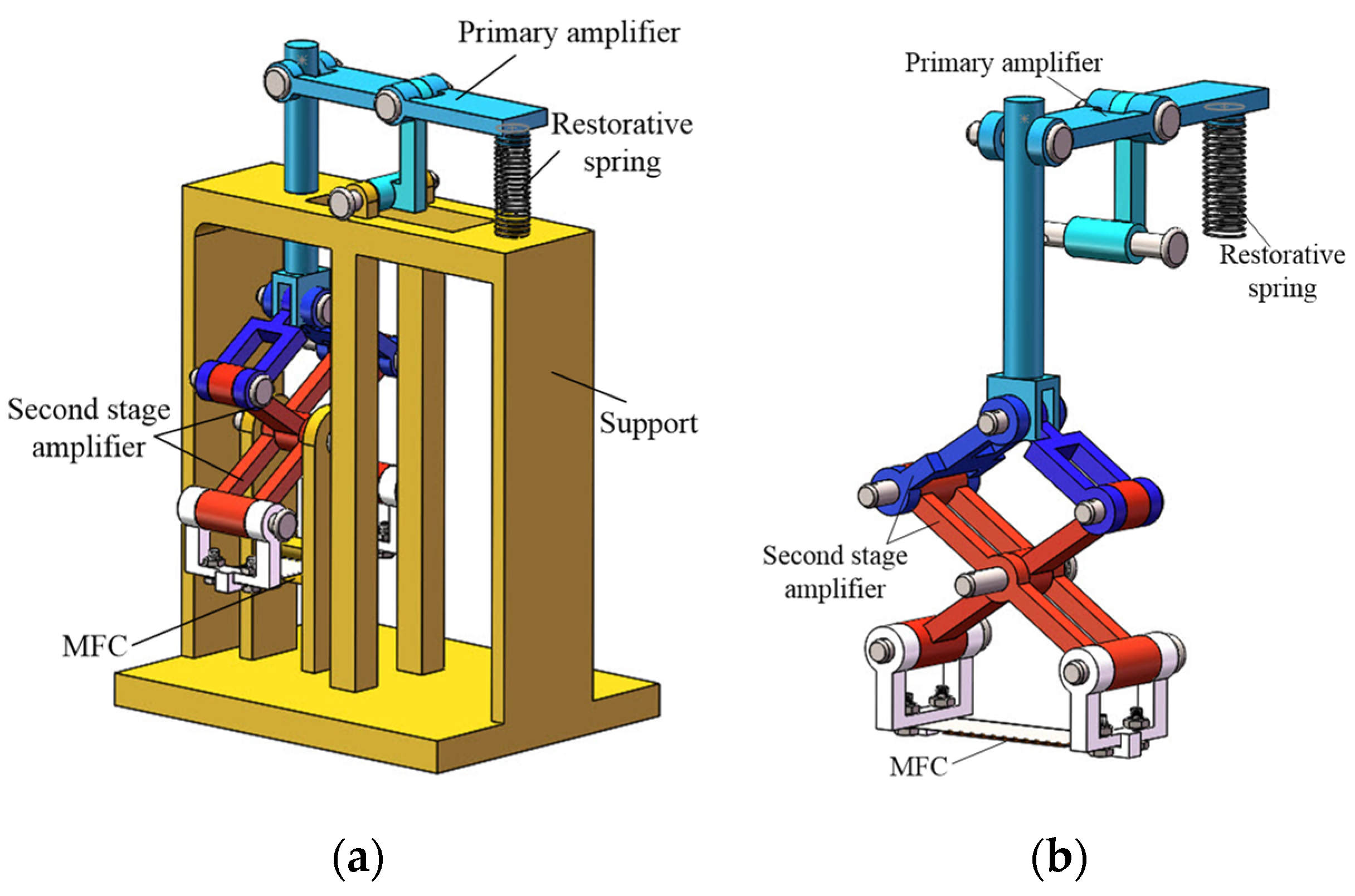
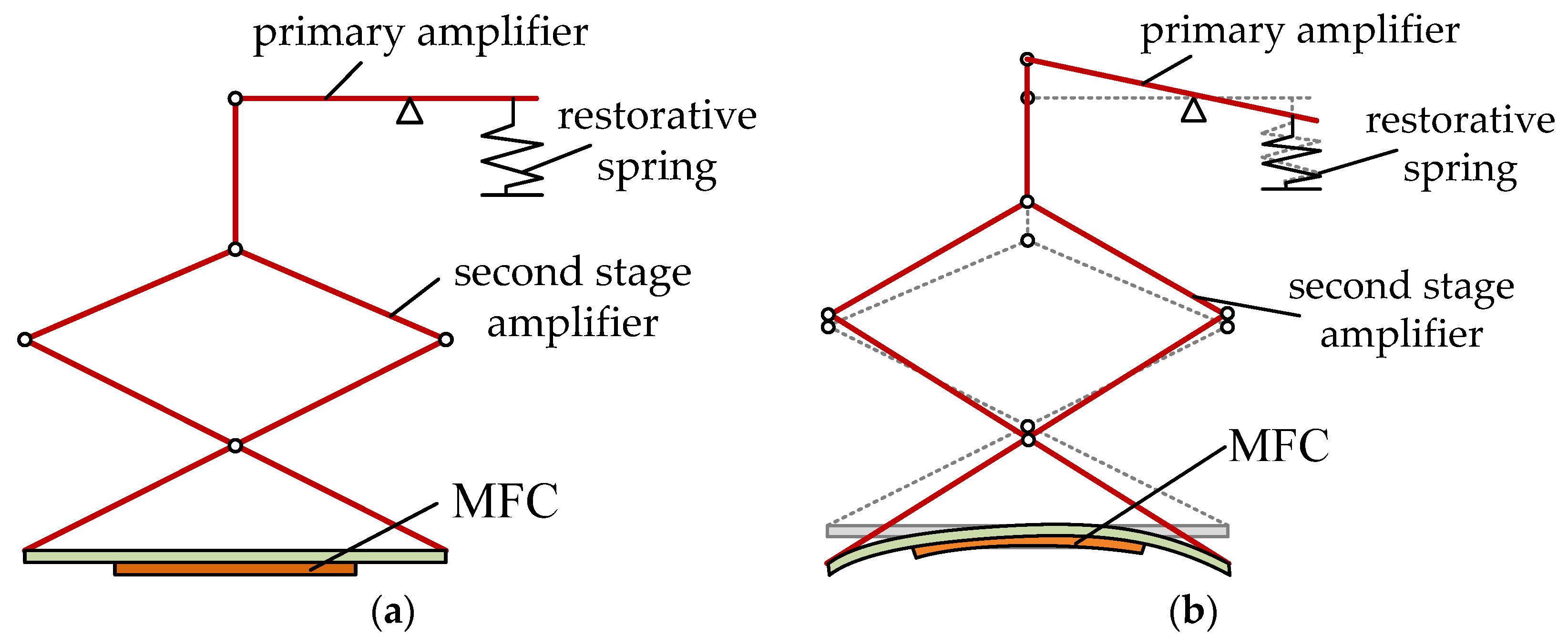

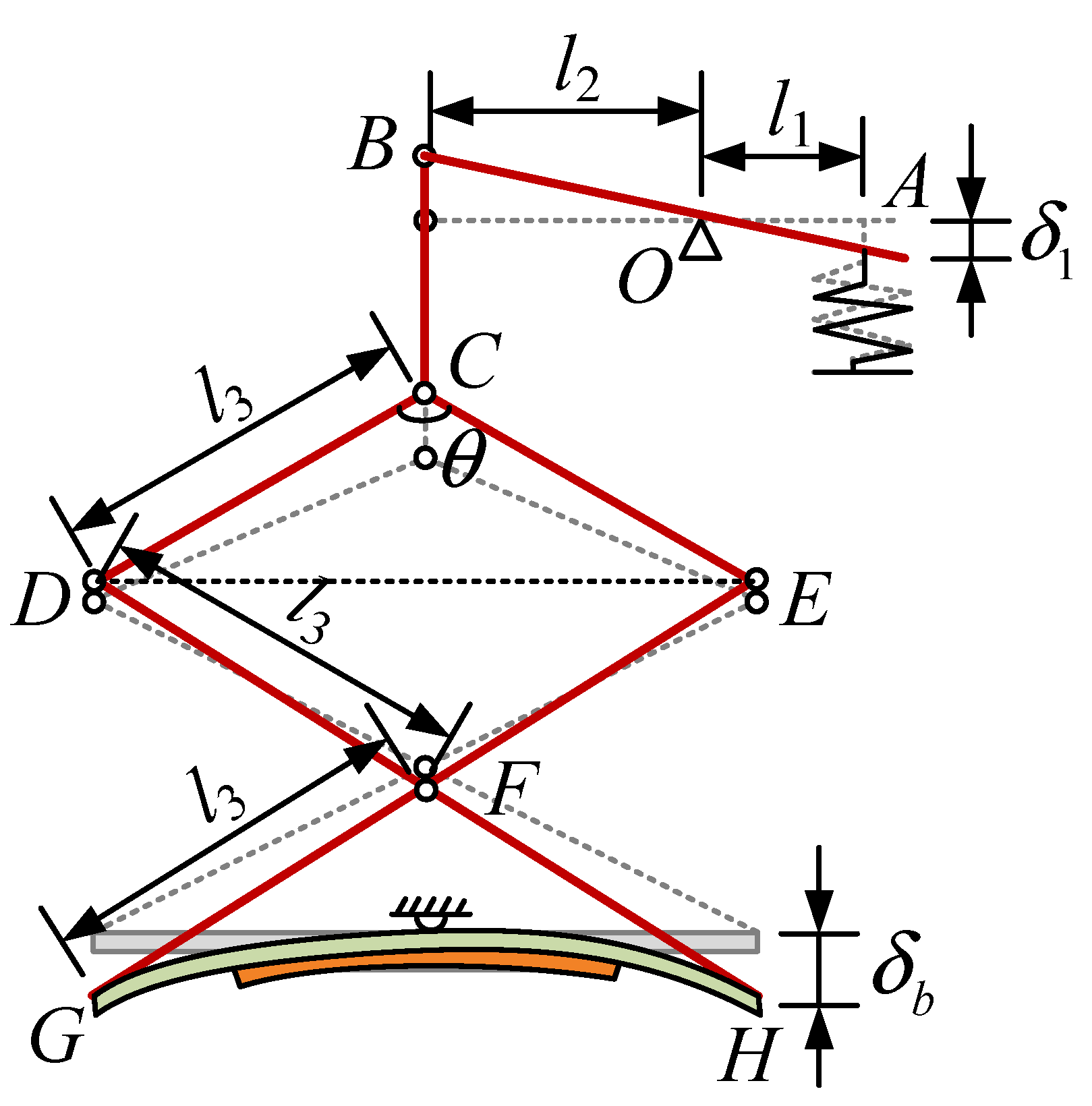
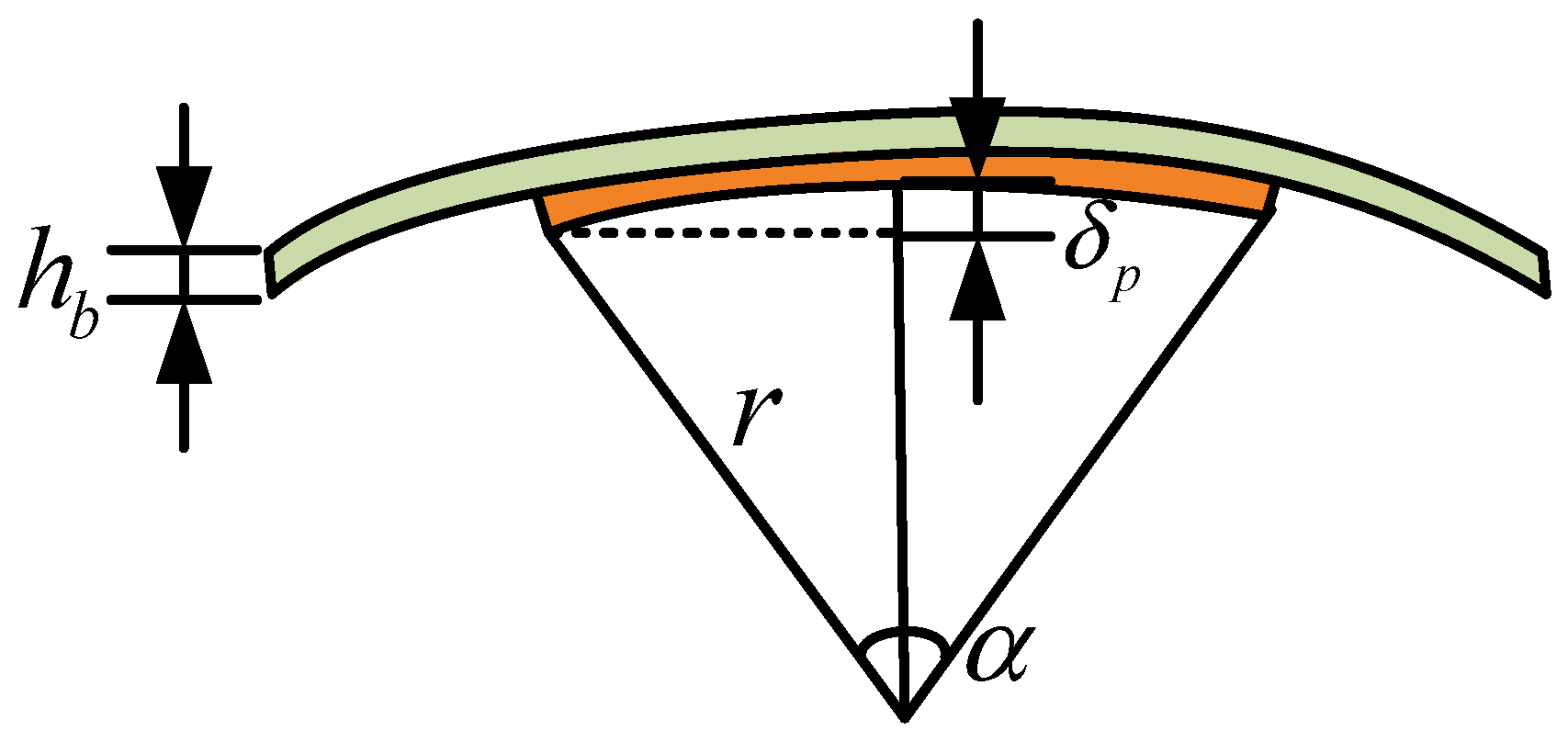
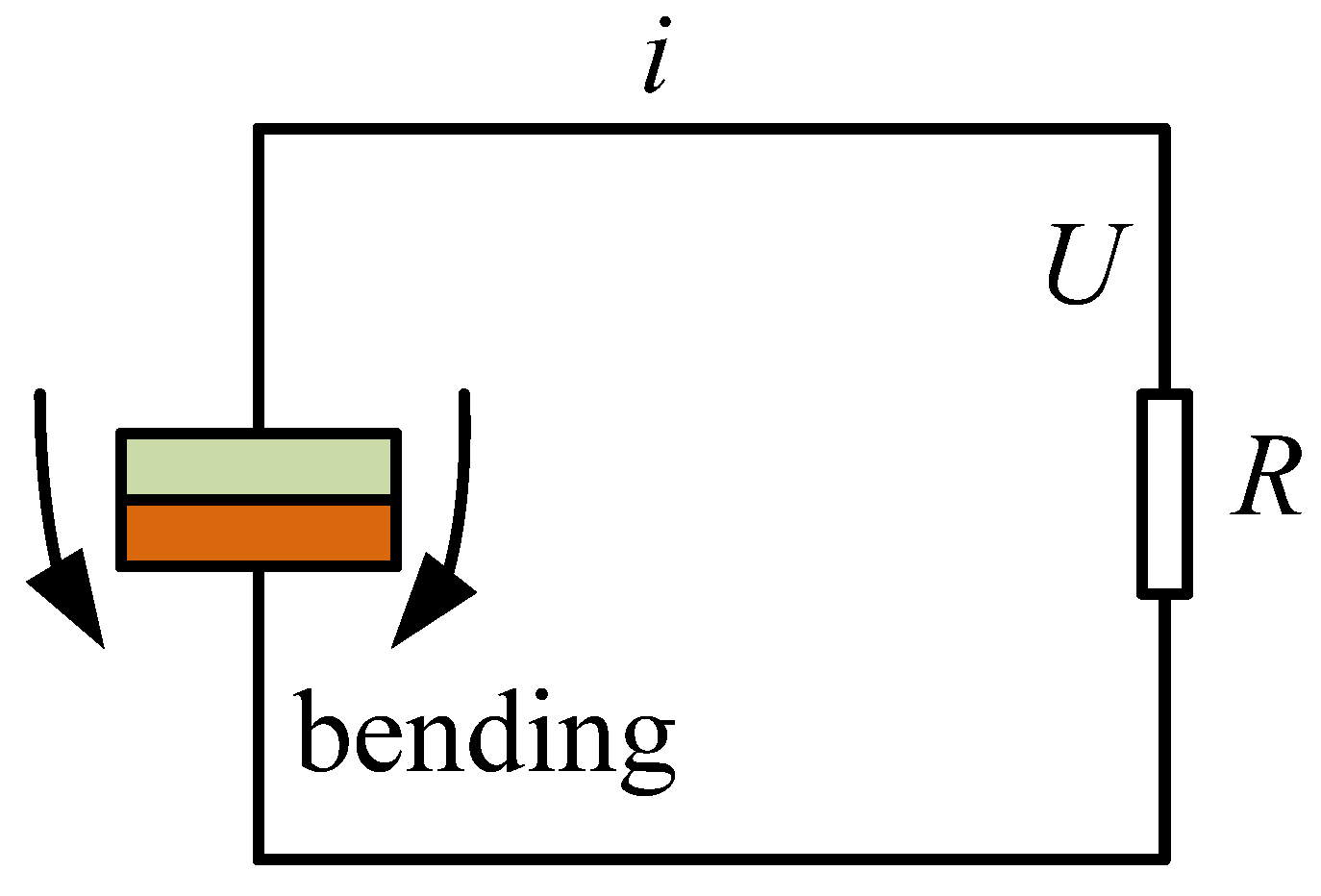
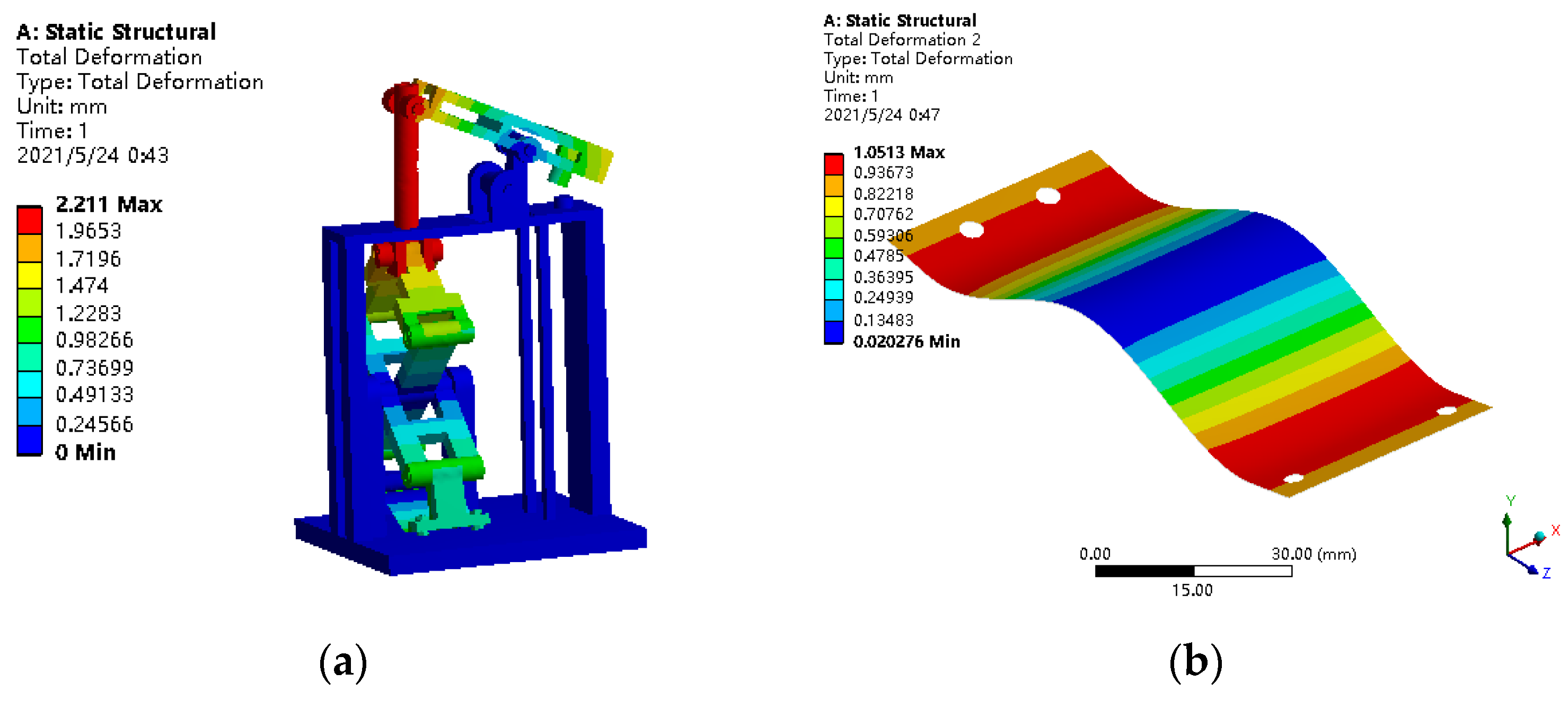


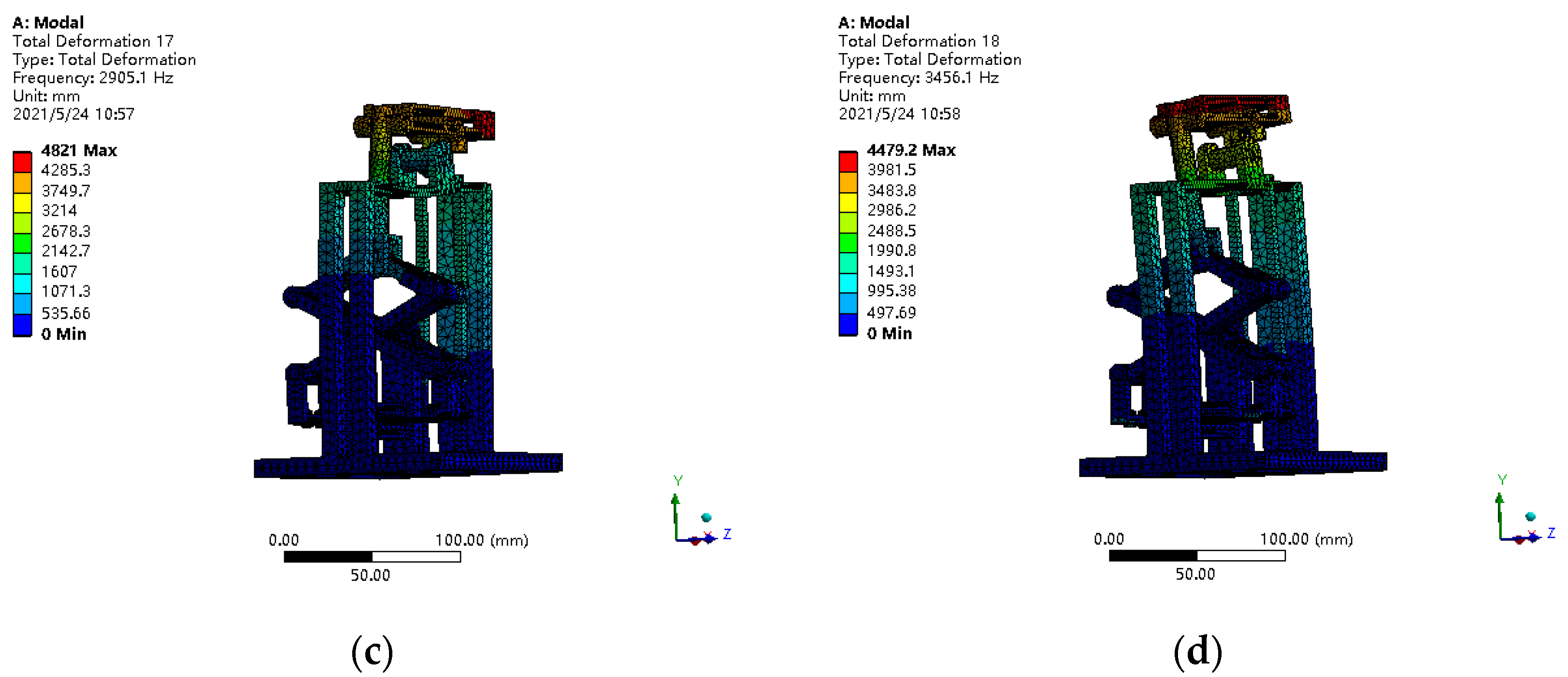
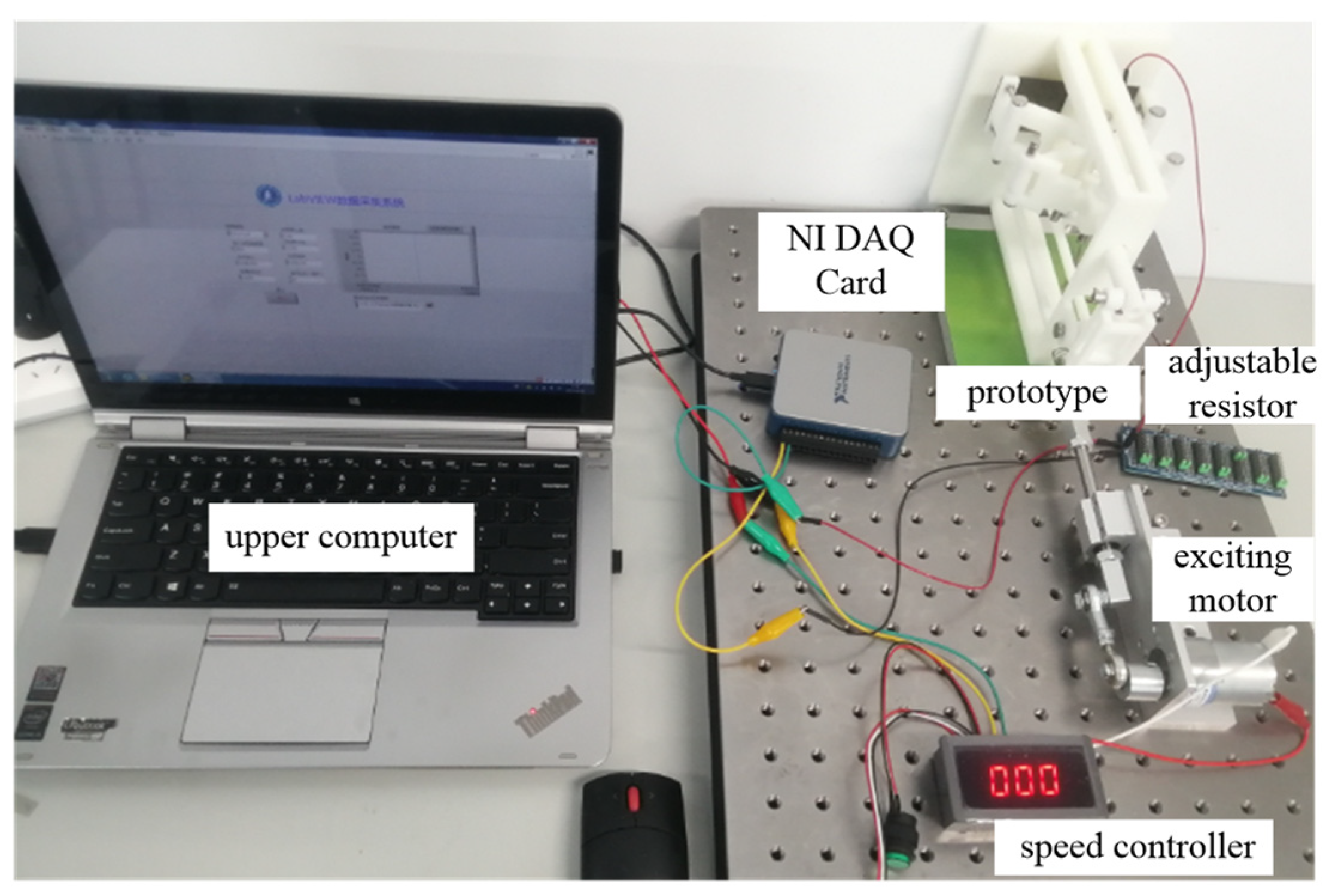


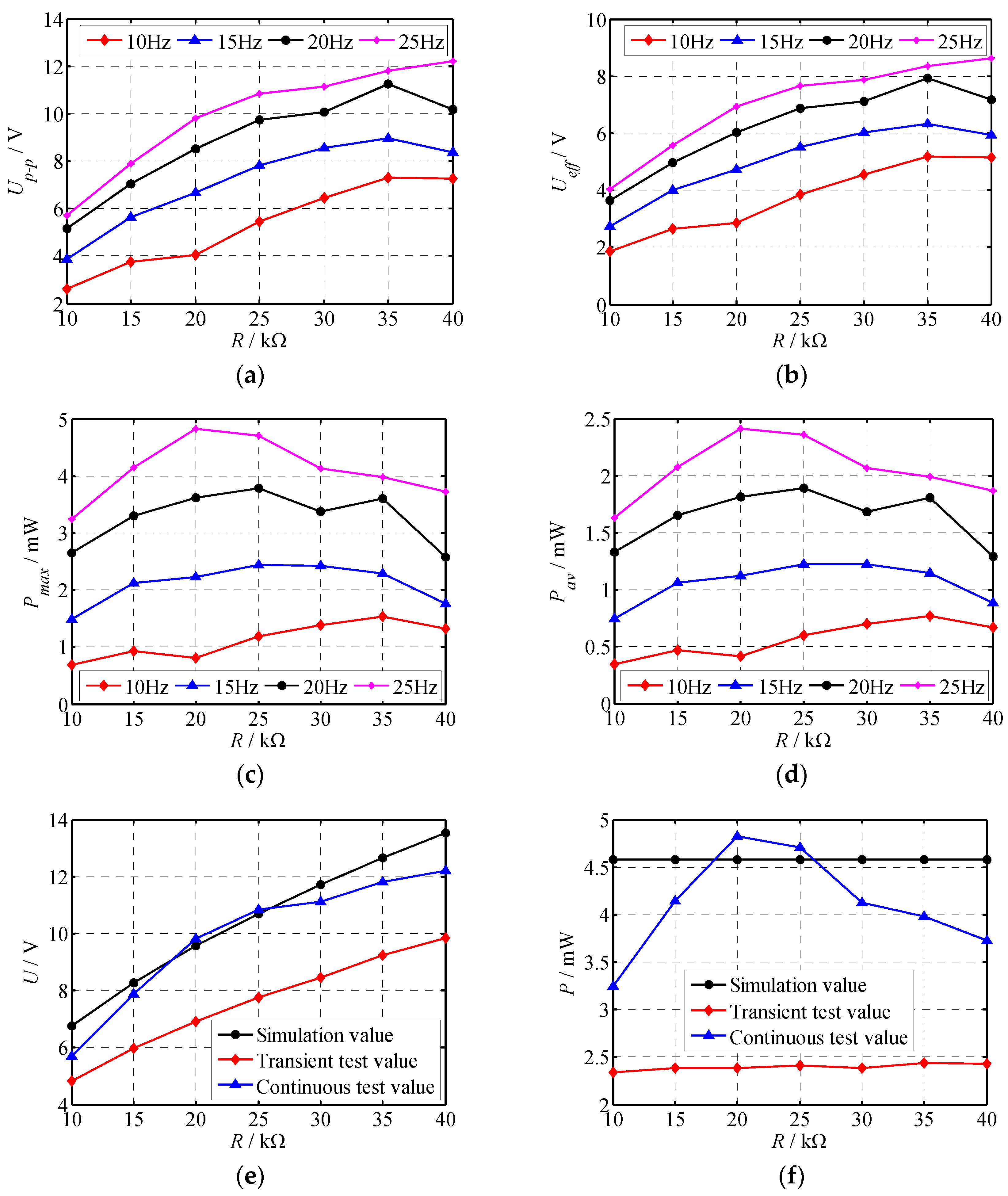
| Materials | PLA | Spring Steels |
|---|---|---|
| Use | Support structure | Elastic vibrator |
| Density (kg/m3) | 1.12 | 7.81 |
| Young’s modius (GPa) | 2.7 | 197 |
| Poisson’s ratio | 0.39 | 0.25 |
| Buk modulus (GPa) | 4.1 | 131 |
| Shear modulus (GPa) | 0.97 | 78.8 |
| Parameter | Values | Parameter | Values |
|---|---|---|---|
| Working mode | d31 | Effective working length | 28 mm |
| Thickness | 300 μm | Effective working width | 14 mm |
| Electrode | Standard lead-free solder S-Sn99Cu1 | Total length | 37 mm |
| Capacitance | 48 nF | Total width | 18 mm |
| Upper limit of operating frequency | <1 MHz |
| Order | First Order | Second Order | Third Order | Fourth Order |
|---|---|---|---|---|
| Frequencies (Hz) | 2107.8 | 2353.9 | 2905.1 | 3456.1 |
Publisher’s Note: MDPI stays neutral with regard to jurisdictional claims in published maps and institutional affiliations. |
© 2022 by the authors. Licensee MDPI, Basel, Switzerland. This article is an open access article distributed under the terms and conditions of the Creative Commons Attribution (CC BY) license (https://creativecommons.org/licenses/by/4.0/).
Share and Cite
Wang, J.; Tong, Y.; Li, C.; Zhang, Z.; Shao, J. A Novel Vibration Piezoelectric Generator Based on Flexible Piezoelectric Film Composed of PZT and PI Layer. Polymers 2022, 14, 2871. https://doi.org/10.3390/polym14142871
Wang J, Tong Y, Li C, Zhang Z, Shao J. A Novel Vibration Piezoelectric Generator Based on Flexible Piezoelectric Film Composed of PZT and PI Layer. Polymers. 2022; 14(14):2871. https://doi.org/10.3390/polym14142871
Chicago/Turabian StyleWang, Jia, Yujian Tong, Chong Li, Zhiguang Zhang, and Jiang Shao. 2022. "A Novel Vibration Piezoelectric Generator Based on Flexible Piezoelectric Film Composed of PZT and PI Layer" Polymers 14, no. 14: 2871. https://doi.org/10.3390/polym14142871
APA StyleWang, J., Tong, Y., Li, C., Zhang, Z., & Shao, J. (2022). A Novel Vibration Piezoelectric Generator Based on Flexible Piezoelectric Film Composed of PZT and PI Layer. Polymers, 14(14), 2871. https://doi.org/10.3390/polym14142871






